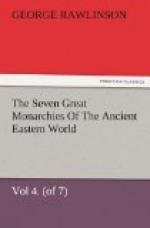There is a bird of the heron species, or rather of a species between the heron and the stork, which seems to deserve a few words of special description. It is found chiefly in Northern Syria, in the plain of Aleppo and the districts watered by the Koweik and Sajur rivers. The Arabs call it Tair-el-Raouf, or “the magnificent.” This bird is of a grayish-white, the breast white, the joints of the wings tipped with scarlet, and the under part of the beak scarlet, the upper part being of a blackish-gray. The beak is nearly five inches long, and two thirds of an inch thick. The circumference of the eye is red; the feet are of a deep yellow; and the bird in its general form strongly resembles the stork; but its color is darker. It is four feet high, and covers a breadth of nine feet when the wings are spread. The birds of this species are wont to collect in large flocks on the North Syrian rivers, and to arrange themselves in several rows across the streams where they are shallowest. Here they squat side by side, as close to one another as possible, and spread out their tails against the current, thus forming a temporary dam. The water drains off below them, and when it has reached its lowest point, at a signal from one of their number who from the bank watches the proceedings, they rise and swoop upon the fish, frogs, etc., which the lowering of the water has exposed to view.
Fish are abundant in the Chaldaean marshes, and in almost all the fresh-water lakes and rivers. [Plate. VIII., Fig.] The Tigris and Euphrates yield chiefly barbel and carp; but the former stream has also eels, trout, chub, shad-fish, siluruses, and many kinds which have no English names. The Koweik contains the Aleppo eel (Ophidium masbacambahis), a very rare variety; and in other streams of Northern Syria are found lampreys, bream, dace, and the black-fish (Macroptero-notus niger), besides carp, trout, chub, and barbel. Chub, bream, and the silurus are taken in the Sea of Galilee. The black-fish is extremely abundant in the Bahr-el-Taka and the Lake of Antioch.
Among reptiles may be noticed, besides snakes, lizards, and frogs, which are numerous, the following less common species—iguanoes, tortoises of two kinds, chameleons, and monitors. Bats also were common in Babylonia Proper, where they grew to a great size. Of insects the most remarkable are scorpions, tarantulas, and locusts. These last come suddenly in countless myriads with the wind, and, settling




